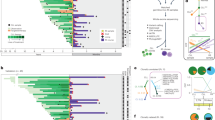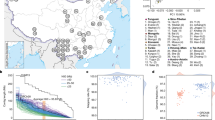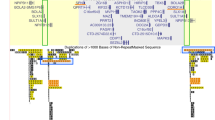Abstract
Investigation of the co-occurrence of panic and phobic disorders with joint laxity led to the identification of interstitial duplications involving human chromosome 15q24–26 (named ‘DUP25’) in a Spanish population. DUP25 was observed in 97% of patients and in 7% of control individuals. In the present study, we used two different methods to detect DUP25: high-throughput molecular gene dosage analysis and fluorescence in situ hybridization (FISH). We evaluated 56 lymphoblastoid cell lines derived from 26 unrelated patients with panic disorder obtained from several European and American populations and 30 normal controls. We could not find any cell line showing a result consistent with DUP25. These data do not support any association of DUP25 with panic disorder.
Similar content being viewed by others
Log in or create a free account to read this content
Gain free access to this article, as well as selected content from this journal and more on nature.com
or
References
Gratacòs M, Nadal M, Martín-Santos R et al: A polymorphic genomic duplication on human chromosome 15 is a susceptibility factor for panic and phobic disorders. Cell 2001; 106: 367–379.
Zimmermann B, Holzgreve W, Wenzel F, Hahn S : Novel real-time quantitative PCR test for trisomy 21. Clin Chem 2002; 48: 362–363.
Telenius H, Carter NP, Bebb CE, Nordenskjold M, Ponder BA, Tunnacliffe A : Degenerate oligonucleotide-primed PCR: general amplification of target DNA by a single degenerate primer. Genomics 1992; 13: 718–725.
Bartsch O, Wagner A, Hinkel GK et al: FISH studies in 45 patients with Rubinstein–Taybi syndrome: deletions associated with polysplenia, hypoplastic left heart and death in infancy. Eur J Hum Genet 1999; 7: 748–756.
Tabiner M, Youings S, Dennis N et al: Failure to find DUP25 in patients with anxiety disorders, in control individuals, or in previously reported positive control cell lines. Am J Hum Genet 2003; 72: 535–538.
Weiland Y, Kraus J, Speicher MR : A multicolor FISH assay does not detect DUP25 in control individuals or in reported positive control cells. Am J Hum Genet 2003; 72: 1349–1352.
Acknowledgements
We thank Dr. Vera Kalscheuer of the Max Planck Institute for Molecular Genetics, Berlin, Germany, for sending DNA of YAC 957b4 and Dr. Mary-Anne Enoch for her assistance in clinical data collection. We also thank Dr. Xavier Estivill and Lluis Armengol for providing DNA of cosmids c251-3 and t216-1.
Author information
Authors and Affiliations
Corresponding author
Rights and permissions
About this article
Cite this article
Zhu, G., Bartsch, O., Skrypnyk, C. et al. Failure to detect DUP25 in lymphoblastoid cells derived from patients with panic disorder and control individuals representing European and American populations. Eur J Hum Genet 12, 505–508 (2004). https://doi.org/10.1038/sj.ejhg.5201181
Received:
Revised:
Accepted:
Published:
Issue date:
DOI: https://doi.org/10.1038/sj.ejhg.5201181
Keywords
This article is cited by
-
Genomic structural variation in affective, anxiety, and stress-related disorders
Journal of Neural Transmission (2015)
-
Evidence for a new contiguous gene syndrome, the chromosome 16p13.3 deletion syndrome alias severe Rubinstein–Taybi syndrome
Human Genetics (2006)
-
Forty-two supernumerary marker chromosomes (SMCs) in 43 273 prenatal samples: chromosomal distribution, clinical findings, and UPD studies
European Journal of Human Genetics (2005)
-
Genetics of anxiety disorders
Current Psychiatry Reports (2004)



